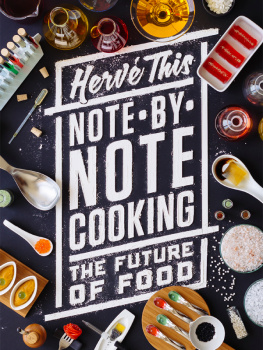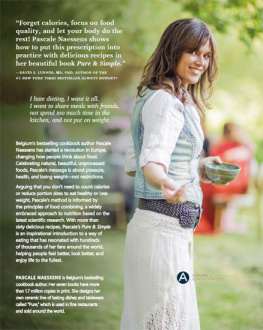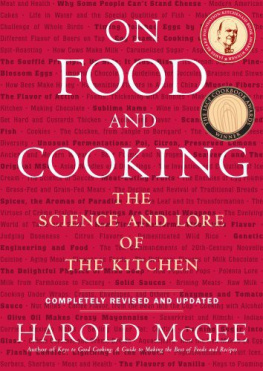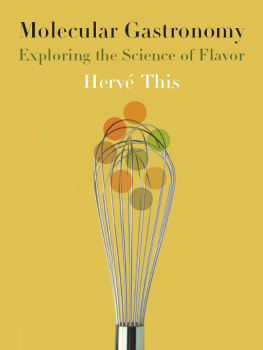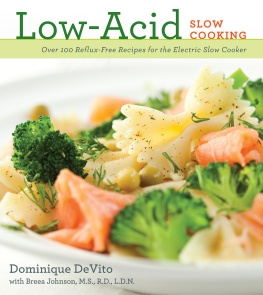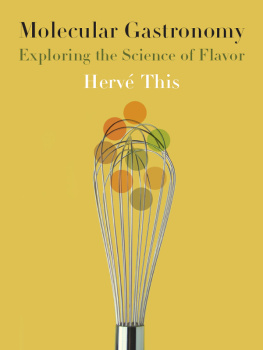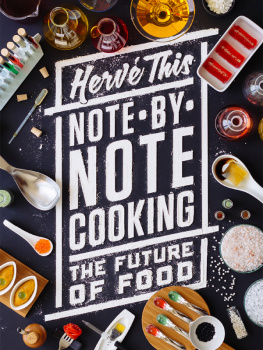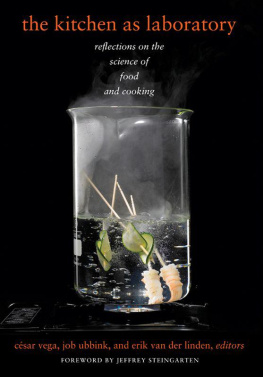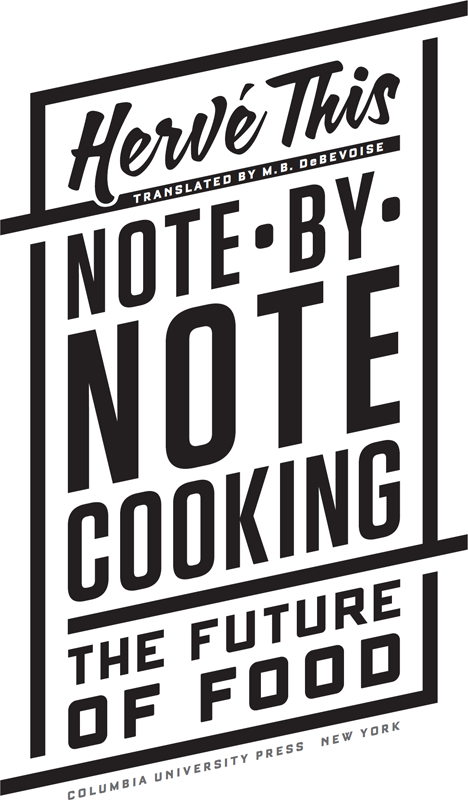Arts & Traditions of the Table
Arts & Traditions of the Table
PERSPECTIVES ON CULINARY HISTORY
ALBERT SONNENFELD, SERIES EDITOR
Salt: Grain of Life
Pierre Laszlo, translated by Mary Beth Mader
Culture of the Fork
Giovanni Rebora, translated by Albert Sonnenfeld
French Gastronomy: The History and Geography of a Passion
Jean-Robert Pitte, translated by Jody Gladding
Pasta: The Story of a Universal Food
Silvano Serventi and Franoise Sabban, translated by Antony Shugar
Slow Food: The Case for Taste
Carlo Petrini, translated by William McCuaig
Italian Cuisine: A Cultural History
Alberto Capatti and Massimo Montanari, translated by ine OHealy
British Food: An Extraordinary Thousand Years of History
Colin Spencer
A Revolution in Eating: How the Quest for Food Shaped America
James E. McWilliams
Sacred Cow, Mad Cow: A History of Food Fears
Madeleine Ferrires, translated by Jody Gladding
Molecular Gastronomy: Exploring the Science of Flavor
Herv This, translated by M. B. DeBevoise
Food Is Culture
Massimo Montanari, translated by Albert Sonnenfeld
Kitchen Mysteries: Revealing the Science of Cooking
Herv This, translated by Jody Gladding
Hog and Hominy: Soul Food from Africa to America
Frederick Douglass Opie
Gastropolis: Food and New York City
Edited by Annie Hauck-Lawson and Jonathan Deutsch
Building a Meal: From Molecular Gastronomy to Culinary Constructivism
Herv This, translated by M. B. DeBevoise
Eating History: Thirty Turning Points in the Making of American Cuisine
Andrew F. Smith
The Science of the Oven
Herv This, translated by Jody Gladding
Pomodoro! A History of the Tomato in Italy
David Gentilcore
Cheese, Pears, and History in a Proverb
Massimo Montanari, translated by Beth Archer Brombert
Food and Faith in Christian Culture
Edited by Ken Albala and Trudy Eden
The Kitchen as Laboratory: Reflections on the Science of Food and Cooking
Edited by Csar Vega, Job Ubbink, and Erik van der Linden
Creamy and Crunchy: An Informal History of Peanut Butter, the All-American Food
Jon Krampner
Let the Meatballs Rest: And Other Stories About Food and Culture
Massimo Montanari, translated by Beth Archer Brombert
The Secret Financial Life of Food: From Commodities Markets to Supermarkets
Kara Newman
Drinking History: Fifteen Turning Points in the Making of American Beverages
Andrew Smith
Italian Identity in the Kitchen, or Food and the Nation
Massimo Montanari, translated by Beth Archer Brombert
Fashioning Appetite: Restaurants and the Making of Modern Identity
Joanne Finkelstein
The Land of the Five Flavors: A Cultural History of Chinese Cuisine
Thomas O. Hllmann, translated by Karen Margolis
The Insect Cookbook
Arnold van Huis, Henk van Gurp, and Marcel Dicke, translated by Franoise Takken-Kaminker and Diane Blumenfeld-Schaap
Religion, Food, and Eating in North America
Edited by Benjamin E. Zeller, Marie W. Dallam, Reid L. Neilson, and Nora L. Rubel
Umami: Unlocking the Secrets of the Fifth Taste
Ole G. Mouritsen and Klavs Styrbk, translated by Mariela Johansen and designed by Jonas Drotner Mouritsen
Chop Suey, USA: The Story of Chinese Food in America
Yong Chen

Columbia University Press
Publishers Since 1893
New York Chichester, West Sussex
cup.columbia.edu
Copyright 2014 Columbia University Press
All rights reserved
E-ISBN 978-0-231-53823-7
Library of Congress Cataloging-in-Publication Data
This, Herv.
[Cuisine note note. English]
Note-by-note cooking : the future of food / Herv This; translated by M. B. DeBevoise.
pages cm (Arts and traditions of the table)
Translation of: La cuisine note note.
Includes bibliographical references and index.
ISBN 978-0-231-16486-3 (cloth : alk. paper) ISBN 978-0-231-53823-7 (ebook)
1. Food additives. 2. Artificial foods. I. Title.
TX553.A3T4613 2014
641.308dc23
2014007035
A Columbia University Press E-book.
CUP would be pleased to hear about your reading experience with this e-book at .
References to Internet Web sites (URLs) were accurate at the time of writing. Neither the author nor Columbia University Press is responsible for URLs that may have expired or changed since the manuscript was prepared.
JACKET DESIGN + BOOK DESIGN + COMPOSITION BY VIN DANG
IL NEST PAS NCESSAIRE DTRE LUGUBRE POUR TRE SRIEUX.
HERV THIS
CONTENTS
THE ENGLISH VERSION of La cuisine note--note differs from the French edition in several ways. At the American publishers request, and with the authors approval, the contents of the original book have been reorganized so that there are now seven main chapters rather than twelve, and a list of further readings has been included at the end of each chapter. The Columbia edition also contains twenty-nine black-and-white illustrations and a section of twenty color plates not found in the book published by Belin in Paris.
A few minor errors of fact have been silently corrected, and here and there biographical and other details have been added as a courtesy to nonspecialist readers. On behalf of the Press I am pleased to thank Herv This for his cheerful cooperation in preparing this revised and expanded edition of his work.
M. B. DeBEVOISE
TABLES
FIGURES
COLOR PLATES
NOTE-BY-NOTE COOKING? Trust me: I always use words with due regard for what they meanbut I dont deny myself the luxury of metaphor. In the phrase note-by-note cooking, the noun that is modified is cooking. In French, the word cuisine denotes a room, the kitchen, but it refers above all to an activity, cooking, well described by the title of a book I wrote a few years ago that was published in English under the title Cooking: The Quintessential Art. The original title is more revealing: La cuisine: Cest de lamour, de lart, de la technique. By this I mean that the cooks primary purpose is to show love (which may or may not be wholly sincerethough the reader will have guessed that I myself favor honesty in matters of the heart) to his or her guests. Beyond that, the cook seeks to make something good, a work of art in the best case, and to make it well, according to some standard of technical excellence.
Lets begin with the simplest part, the technical aspect. Culinary activity physically assumes the form of a series of operations: cutting, heating, grinding, filtering, evaporating, assembling, melting, blending, emulsifying, mixing, expandingexactly the same things, as it happens, that are done in the marvelous field of chemistry. There is nothing in the least surprising about this: chemistry, like cooking, has a technical component. But this component is almost an incidental detail. Chemistry, though it involves technique, is not merely a matter of doing. It is also a science, a search for the underlying mechanisms of phenomena whose aim is to acquire knowledge. What does it mean to say, then, that cooking has a technical component? It means that cooking is not solely a matter of technique, as most people suppose. There is much, much more to it than that.

